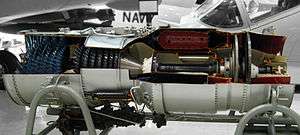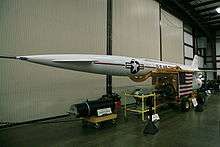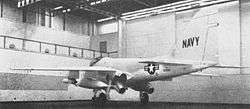Pratt & Whitney J52
| J52/JT8A | |
|---|---|
 | |
| A J52 cut-out showing its two spools | |
| Type | Turbojet |
| National origin | United States |
| Manufacturer | Pratt & Whitney |
| First run | 1955 |
| Major applications | Douglas A-4 Skyhawk Grumman A-6 Intruder Northrop Grumman EA-6B Prowler |
| Number built | >5,000[1] |
| Developed from | Pratt & Whitney J57 |
| Developed into | Pratt & Whitney JT8D |
The Pratt & Whitney J52 (company designation JT8A) is an axial-flow dual-spool turbojet engine originally designed for the United States Navy,[2] in the 9,000 lbf-class. It powered the A-6 Intruder and the AGM-28 Hound Dog cruise missile. The engine is still in use in 2011 in models of the A-4 Skyhawk and the EA-6B Prowler.
The engine provided the basis for the Pratt & Whitney JT8D, a popular civilian low-bypass turbofan engine.
Design and development
The J52 was developed in the mid-1950s for the US Navy as a scaled-down derivative of the J57/JT3A.[3] It was initially intended to power the A4D-3 Skyhawk, an advanced avionics model that was canceled in 1957. After being canceled, the U.S. Air Force selected the J52 to power the AGM-28 Hound Dog cruise missile. The engine was designed with several unique features for this application, including a "conical centerbody mounted in the intake" and a "variable central plug ... in the nozzle".[4] Then, in 1958, the US Navy selected the engine to power what became the A-6 Intruder.
The J52-P-6 model, designed for the YA2F-1 (YA-6A) Intruder, had a unique nozzle that could be angled downward at 23 degrees for STOL takeoffs; this was not used on production A-6s. Returning full circle, the J52 was selected to power the A4D-5, another model of the A-4 Skyhawk, remaining in all subsequent new-built models.[5]
The twin-spool J52 employs a split 12-stage axial compressor consisting of a five-stage low pressure unit and a seven-stage high pressure unit. Behind the compressor is a nine-unit can-annular combustion chamber and a two-stage split turbine.
Variants


- J52-P-3
- Flown in: AGM-28 Hound Dog. This variant produced 7,500 lbf (33,000 N) of thrust. The design of the P-3 model included a variable inlet duct to improve engine efficiency at the various altitudes the cruise missile was designed to fly at.[6]
- J52-P-6
- Flown in: A-6A. This variant produced 8,500 lbf (38,000 N) of thrust and included the 23-degree downward swiveling nozzle.
- J52-P6A
- Flown in: A-4E, TA-4J, EA-6B (the first few). This variant produced 8,500 lbf (38,000 N) of thrust.
- J52-P-8A/B
- Flown in: A-4F/G/H/K, TA-4E/F/G/H, A-6E, EA-6B. This variant produced 9,300 lbf (41,000 N) of thrust.
- J52-P-408
- Flown in: A-4M/N, TA-4KU, EA-6B. This variant included variable inlet guide vanes (VIGV) in the LPC, air-cooled turbine blades, and produced 11,200 lbf (50,000 N) of thrust.[7] Still in operation with Israel, Argentina, Brazil, and Indonesia
- J52-P-409
- Also known as PW1212. 12,000 lbf (53 kN) thrust version of the J52-P-408 with an improved low pressure turbine (LPT) and faster acceleration. Designed for the EA-6B and was additionally marketed as an upgrade for the A-4. The J52-P-409 was also proposed as a cost-effective upgrade to the A-6E as an alternative to the A-6F Intruder II,[8] but was not purchased. The P-409 engine was also proposed for use in the EA-6B ADVCAP,[9] but that program was canceled after three prototypes were built and flown. The P-409 would have been available as a new engine or as an upgrade kit for P-408 engines, but was never ordered in significant quantities.[10][11]
- PW1216
- An afterburning derivative of the J52-P409 engine proposed for the Grumman Sabre II concept (the project later evolved into the JF-17 Thunder). The afterburner, designed in China, would have increased thrust to 16,000 lbf (71 kN).[12]
- JT8A
- Company designation for initial versions of the J52
- JT8B-1
- (J52-P-6)
Applications
- AGM-28 Hound Dog
- Dassault Super Mystere
- Douglas A-4 Skyhawk
- Grumman A-6 Intruder
- Lockheed Martin A-4AR Fightinghawk
- Northrop Grumman EA-6B Prowler
- LIMRV - On 14 August 1974, the LIMRV achieved a world record speed of 255.7 mph (411.5 km/h)
Specifications (J52-P-408)
Data from Flight [13]
General characteristics
- Type: Turbojet
- Length: 118 in (300 cm)
- Diameter: 38 in (81.4 cm)
- Dry weight: 2,318 lb (1,052 kg)
Components
- Compressor: Axial flow, 5-stage LP, 7-stage HP
- Turbine: Single stage HP, single stage LP
- Fuel type: JP-4
Performance
- Maximum thrust: 11,200 lbf (50.0kN)
- Overall pressure ratio: 14.6 : 1
- Air mass flow: 143 lb/sec
- Specific fuel consumption: 0.89 lb/lbf*hr
- Thrust-to-weight ratio: 4.83:1
See also
- Related development
- Comparable engines
- Related lists
References
Notes
- ↑ Pratt & Whitney J52 page. Accessed 28 May 2016.
- ↑ Gunston 1989, p.122.
- ↑ Gunston 2006, p.154
- ↑ Quotations from Flight, 1961,
- ↑ Aero Engines 1961 (1961). Flight, July 20, 1961. pp 93-94.
- ↑ Griswold, W.S., "Mightiest Bomber Fires 1,000 Mile Missile" (1958). Popular Science. Sept. 1958, p.90-91.
- ↑ A-4 Skyhawk technical information - skyhawk.org Retrieved: 29 July 2009
- ↑ Greeley, B.M. Jr., "Congressional Clash Threatens A-6F, A-6E Compromise Effort" (1988). Aviation Week & Space Technology, Jan. 11, 1988. p.18.
- ↑ Polmar, N. "EA-6B Prowler" (2001). The Naval Institute Guide to Ships and Aircraft of the U.S. Fleet, 17th Ed. 2001. p416-417.
- ↑ "P&W provides more EA-6 power" (1987). Flight International, Sept. 19, 1987. p.15.
- ↑ "Uprated A-4 Marketed" (1988). Flight International, Feb. 13, 1988. p.16.
- ↑ "Pratt & Whitney's PW1216 turbojet" (1987). Flight International. September 26, 1987. Page 62.
- ↑ Flightglobal archive - Flight International, 4 January 1973 Retrieved: 29 July 2009
Bibliography
- Gunston, Bill. World Encyclopedia of Aero Engines. Cambridge, England. Patrick Stephens Limited, 1989. ISBN 1-85260-163-9
- Jane's Information Group. Pratt & Whitney J52. Jane's Aero Engines. Modified 29 May 2009.
- Gunston, Bill (2006). The Development of Jet and Turbine Aero Engines, 4th Edition. Sparkford, Somerset, England, UK: Patrick Stephens, Haynes Publishing. ISBN 0-7509-4477-3.
External links
| Wikimedia Commons has media related to Pratt & Whitney J52. |